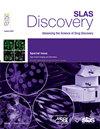用于基于图像的分析分析的替代染料。
IF 2.7
4区 生物学
Q2 BIOCHEMICAL RESEARCH METHODS
引用次数: 0
摘要
背景:细胞染色是一种领先的基于图像的分析方法,它涉及用六种染料对被镀的细胞进行染色,以标记细胞中的不同区室。这样的概况可以用来发现样品之间的联系(无论是不同的细胞系,不同的基因处理,还是不同的化合物处理),以及评估每种处理影响的特定特征。研究人员可能希望改变标准染料面板,以评估特定的表型,或者在保持整体聚类概况的能力的同时对细胞进行成像。方法:在本研究中,我们评估了染料的性能,这些染料可以替代或增强传统的细胞绘画染料,也可以跟踪活细胞的动态。我们用90种不同的化合物对U2OS细胞进行干扰,然后用标准细胞染色染料(Revvity)或用MitoBrilliant (Tocris)代替MitoTracker或Phenovue phalloidin 400LS (Revvity)代替phalloidin进行染色。我们还测试了活细胞兼容的ChromaLive染料(Saguaro)。结果:所有染料组都有效地分离了相同样品的生物重复与阴性对照(表型活性),尽管从所有其他化合物的重复中分离(表型特异性)证明对所有染料组都具有挑战性。虽然在标准细胞染色面板中单个染料的替换对分析性能的影响最小,但与标准面板相比,活细胞染料在不同化合物类别中表现出不同的性能特征,后期时间点比早期时间点更加明显。讨论:用MitoBrilliant或Phenovue phalloidin 400LS替代标准线粒体或肌动蛋白染料,对细胞绘画实验性能影响最小。Phenovue phalloidin 400LS提供了从高尔基体或质膜分离肌动蛋白特征的优势,同时容纳额外的568nm染料。由ChromaLive染料激活的活细胞成像提供了化合物诱导的形态学变化的实时评估。将此与标准细胞涂画分析相结合,显着扩展了增强细胞分析的特征空间。我们的研究结果为研究人员选择染料组进行基于图像的分析提供了数据驱动的选择。本文章由计算机程序翻译,如有差异,请以英文原文为准。
Alternate dyes for image-based profiling assays
Background
Cell Painting, the leading image-based profiling assay, involves staining plated cells with six dyes that mark the different compartments in a cell. Such profiles can then be used to discover connections between samples (whether different cell lines, different genetic treatments, or different compound treatments) as well as to assess particular features impacted by each treatment. Researchers may wish to vary the standard dye panel to assess particular phenotypes, or image cells live while maintaining the ability to cluster profiles overall.
Methods
In this study, we evaluate the performance of dyes that can either replace or augment the traditional Cell Painting dyes or enable tracking live cell dynamics. We perturbed U2OS cells with 90 different compounds and subsequently stained them with either standard Cell Painting dyes (Revvity), or with MitoBrilliant (Tocris) replacing MitoTracker or Phenovue phalloidin 400LS (Revvity) replacing phalloidin. We also tested the live-cell compatible ChromaLive dye (Saguaro).
Results
All dye sets effectively separated biological replicates of the same sample vs. negative controls (phenotypic activity), although separating from replicates of all other compounds (phenotypic distinctiveness) proved challenging for all dye sets. While individual dye substitutions within the standard Cell Painting panel had minimal impact on assay performance, the live cell dye exhibited distinct performance profiles across different compound classes compared to the standard panel, with later time points more distinct than earlier ones.
Discussion
Substituting MitoBrilliant or Phenovue phalloidin 400LS for standard mitochondrial or actin dyes minimally impacted Cell Painting assay performance. Phenovue phalloidin 400LS offers the advantage of isolating actin features from Golgi or plasma membrane while accommodating an additional 568 nm dye. Live cell imaging, enabled by ChromaLive dye, provides real-time assessment of compound-induced morphological changes. Combining this with the standard Cell Painting assay significantly expands the feature space for enhanced cellular profiling. Our findings provide data-driven options for researchers selecting dye sets for image-based profiling.
求助全文
通过发布文献求助,成功后即可免费获取论文全文。
去求助
来源期刊

SLAS Discovery
Chemistry-Analytical Chemistry
CiteScore
7.00
自引率
3.20%
发文量
58
审稿时长
39 days
期刊介绍:
Advancing Life Sciences R&D: SLAS Discovery reports how scientists develop and utilize novel technologies and/or approaches to provide and characterize chemical and biological tools to understand and treat human disease.
SLAS Discovery is a peer-reviewed journal that publishes scientific reports that enable and improve target validation, evaluate current drug discovery technologies, provide novel research tools, and incorporate research approaches that enhance depth of knowledge and drug discovery success.
SLAS Discovery emphasizes scientific and technical advances in target identification/validation (including chemical probes, RNA silencing, gene editing technologies); biomarker discovery; assay development; virtual, medium- or high-throughput screening (biochemical and biological, biophysical, phenotypic, toxicological, ADME); lead generation/optimization; chemical biology; and informatics (data analysis, image analysis, statistics, bio- and chemo-informatics). Review articles on target biology, new paradigms in drug discovery and advances in drug discovery technologies.
SLAS Discovery is of particular interest to those involved in analytical chemistry, applied microbiology, automation, biochemistry, bioengineering, biomedical optics, biotechnology, bioinformatics, cell biology, DNA science and technology, genetics, information technology, medicinal chemistry, molecular biology, natural products chemistry, organic chemistry, pharmacology, spectroscopy, and toxicology.
SLAS Discovery is a member of the Committee on Publication Ethics (COPE) and was published previously (1996-2016) as the Journal of Biomolecular Screening (JBS).
 求助内容:
求助内容: 应助结果提醒方式:
应助结果提醒方式:


